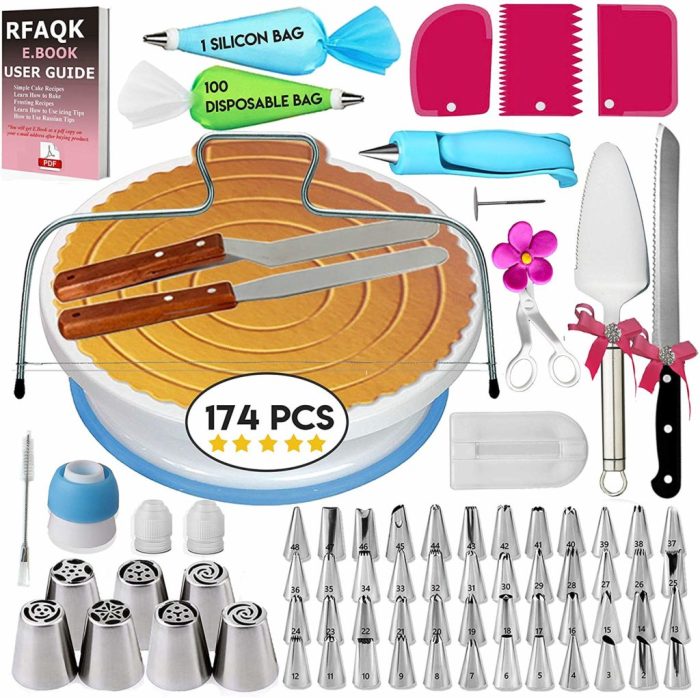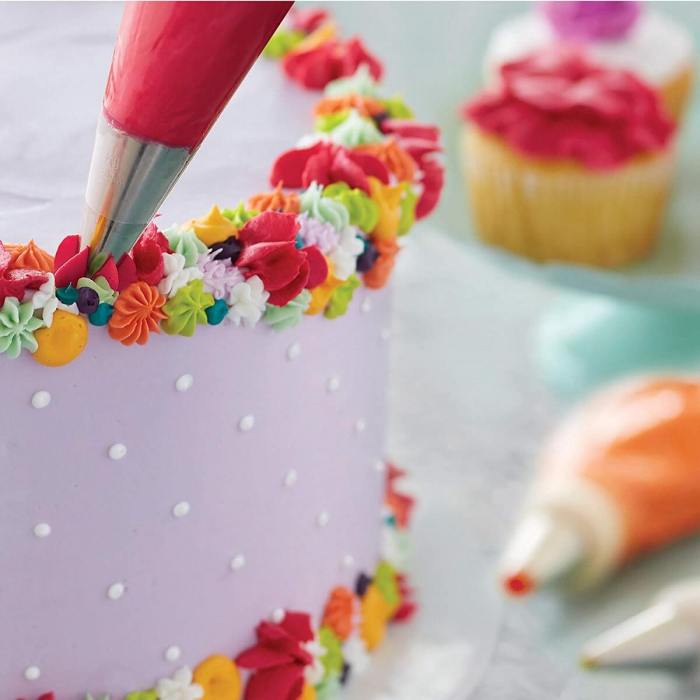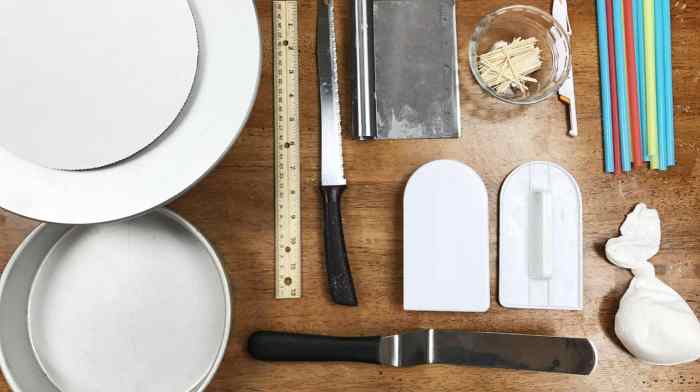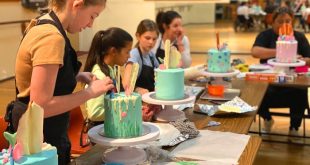Cake Decorating Tools: Your Creative Arsenal
The world of cake decorating is a vibrant canvas, where imagination knows no bounds. But even the most breathtaking designs begin with the right tools. This exploration delves into the fascinating realm of cake decorating tools, guiding you through their types, selection, effective use, creative applications, and essential maintenance.
Types of Cake Decorating Tools
A diverse range of tools empowers cake decorators to translate their visions into reality. These tools fall broadly into categories based on their primary function: frosting, shaping, and writing. Professional and home-use tools differ primarily in their durability, precision, and overall cost. Professional tools are typically made from higher-quality materials and are designed for more frequent and intensive use.
| Tool Name | Function | Material | Price Range |
|---|---|---|---|
| Piping Bags & Tips | Frosting, writing, creating intricate designs | Plastic, reusable silicone, metal | $5 – $50+ (depending on set size and quality) |
| Spatulas (Offset & Bench) | Frosting, smoothing, spreading | Metal, silicone, plastic | $5 – $20 |
| Cake Smoothers | Creating perfectly smooth surfaces | Plastic, metal | $10 – $30 |
| Cake Turntable | Easy cake rotation for even frosting | Plastic, metal | $15 – $50 |
| Rolling Pin | Rolling out fondant and gum paste | Wood, metal, acrylic | $10 – $30 |
| Fondant Smoother | Creating a smooth fondant surface | Plastic, silicone | $5 – $15 |
| Flower Nail | Supporting gum paste and fondant flowers during creation | Plastic, metal | $2 – $10 |
| Gum Paste Cutters | Creating various shapes from gum paste | Plastic, metal | $5 – $30+ (per set) |
| Airbrush System | Applying fine color sprays for intricate designs | Plastic, metal | $50 – $200+ |
Specialized tools exist for specific techniques, such as gum paste flower cutters and molds for creating realistic blossoms, or fondant sculpting tools for intricate character modeling.
Choosing the Right Tools for Different Cakes

Source: diys.com
The tools needed vary greatly depending on the type of cake and desired decorating style. Layer cakes often require spatulas, cake smoothers, and piping bags for frosting and decorative elements. Cupcakes, on the other hand, may primarily need piping bags and tips for individual designs. Sculpted cakes demand a wider array of tools, including sculpting tools, carving knives, and possibly even an airbrush system.
For buttercream roses, piping bags with specific rose tips are essential. Fondant-covered cakes require rolling pins, fondant smoothers, and possibly cutters. Airbrushing requires an airbrush system, stencils, and edible food coloring.
Beginners might start with a basic set including spatulas, piping bags, a few tips, and a turntable. Intermediate decorators may add specialized tips and tools for more complex designs. Advanced decorators often invest in professional-grade tools and specialized equipment such as airbrush systems.
A flowchart for selecting tools for a specific cake design would begin with identifying the cake type (layer, cupcake, sculpted, etc.), then the decorating style (buttercream, fondant, airbrushed, etc.), followed by selecting the necessary tools based on the complexity and techniques involved.
Using Cake Decorating Tools Effectively
Proper technique is key to achieving professional results. For instance, filling a piping bag correctly, holding it at the right angle, and applying consistent pressure are crucial for creating even swirls and precise lines. Cake smoothers should be used with a light touch to avoid damaging the cake layers. Spatulas should be used with a confident yet gentle hand to ensure even frosting.
Cleaning and maintenance are vital for tool longevity. Piping tips should be washed immediately after use to prevent clogging. Spatulas and smoothers can be wiped clean or washed with warm, soapy water. Storing tools properly, ideally in a dedicated case or container, prevents damage and keeps them organized.
Creating swirls with a piping bag involves filling the bag, holding it at a 90-degree angle to the cake, and applying even pressure while rotating the bag to create a spiral pattern. Practice on parchment paper is essential before decorating the actual cake.
Creative Applications of Cake Decorating Tools

Source: insteading.com
Many cake decorating tools can be used in unexpected ways to enhance creativity. For example, a small offset spatula can be used to create delicate leaf patterns on a cake, or a pastry bag with a small round tip can be used to create textured dots or small decorations. Even a simple toothpick can be used to create fine lines or details.
The burgeoning world of cake decorating demands specialized tools, from intricate piping tips to smoothing spatulas. Finding the perfect space to hone these skills, however, requires careful consideration; perhaps a spacious kitchen in one of the houses for rent in Albuquerque would be ideal. Ultimately, the right tools and environment are key to creating stunning, professional-quality cakes.
Three unique cake decorating projects using a limited set of tools could include: (1) a simple buttercream-frosted cake decorated with piped rosettes and a piped border using only a piping bag and two tips; (2) a fondant-covered cake with geometric designs created using a rolling pin, fondant cutter, and a knife; (3) a rustic-style cake with piped buttercream swirls and fresh fruit garnishes using a piping bag and a spatula.
A visual guide showcasing unexpected uses for cake decorating tools might depict a small offset spatula used to create delicate petal shapes on a buttercream flower, a piping bag used to create textured patterns on a fondant surface, or a toothpick used to add fine details to a sculpted cake element. The image would emphasize the versatility of seemingly simple tools.
Cake Decorating Tool Maintenance and Storage, Cake decorating tools

Source: sugargeekshow.com
Proper cleaning and storage are crucial for maintaining hygiene and extending the life of your tools. Wash all tools thoroughly with warm, soapy water after each use, ensuring all traces of batter, frosting, and fondant are removed. Air dry tools completely before storing them in a designated container or case.
Troubleshooting common problems includes cleaning clogged piping tips by soaking them in warm, soapy water or using a pipe cleaner. Damaged spatulas or smoothers may require replacement. A regular maintenance checklist would include washing and drying all tools after each use, checking for damage, and replacing worn-out items.
Recommended cleaning supplies include mild dish soap, warm water, and pipe cleaners. Storage solutions include airtight containers, tool cases, and drawer organizers.
User Queries
What is the best piping bag material for beginners?
The burgeoning world of cake decorating offers a vast array of tools, from simple spatulas to intricate piping nozzles. Finding the right tools can be as challenging as finding the perfect home, much like the search for houses for rent in Tampa FL , which requires careful consideration of needs and budget. Ultimately, both successful cake decorating and securing a suitable rental property hinge on thorough research and informed decision-making regarding available resources.
Disposable piping bags are ideal for beginners due to their affordability and ease of use. They eliminate the need for washing and are readily available in various sizes.
How do I prevent my buttercream from drying out while decorating?
Keep your buttercream covered with a damp cloth or plastic wrap when not actively using it to prevent it from drying out and becoming difficult to pipe.
How often should I replace my piping tips?
The lifespan of piping tips depends on usage, but it’s advisable to replace them when they become bent, damaged, or show signs of wear that affect the quality of your piping.
What’s the best way to clean intricate piping tips?
Use a piping tip cleaner brush or a thin, flexible wire to thoroughly clean the inside and outside of intricate piping tips, ensuring no residue remains.
 Interior Living
Interior Living
